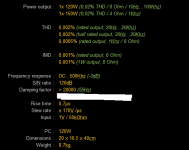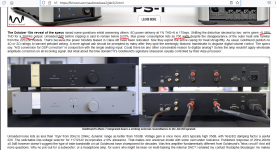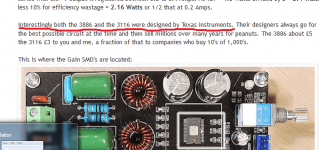Has anyone compared the Purifi and Pascal class D modules (preferably with the Purifi stock input buffer)? I'm looking to buy one or the other from VTV. Internet searches have come up blank.
I recently picked up the ClassDAudio Mini GaN 5 out of curiosity and, in isolation, it's quite good. I want to compare it to either Pascal (which I'm told is a dark horse) or Purifi once I establish which is superior sonically. I'll also be able to compare it to a SS push pull class A amp once it arrives back to me early next week (although there is a10X power difference between the two).
I recently picked up the ClassDAudio Mini GaN 5 out of curiosity and, in isolation, it's quite good. I want to compare it to either Pascal (which I'm told is a dark horse) or Purifi once I establish which is superior sonically. I'll also be able to compare it to a SS push pull class A amp once it arrives back to me early next week (although there is a10X power difference between the two).
They both start with a "P"....Choosing such mareketing names never appealed to me.It reminds me of Orange entering the guitar amplifier scene with some orange painted look for kids tube heads... making a fool of highly praised brands with gold and platinum letters on them once you turn it on and hear it...
On the other hand looking at class d new amp prices is hilarious...
All the electric efficiency of class d cheapness goes into the on the shelf price now...https://www.classdaudio.com/mini-gan-5-balanced-power-amplifier.html
Are you kidding me? More than a 1000 dollars on a thing that doesn't even work for more than 2...3 years and pretty much unrepairable?
https://vtvamplifier.com/product/vtv-amplifier-stereo-purifi-audio-1et400a-amplifier/I know class ab amps from theh 80's that still work and measure better than these new cladd d amps without a single component changed...and i don't need to pay more than 500 euros on a second hand like that even in perfect condition with all electrolitic capacitors newly changed. Now tell me it's the electric efficiency that you are paying 700 more euros on for a purify...yet I bet it's the marketing and the convenience of having a lightweight amp to show off with...
On the other hand looking at class d new amp prices is hilarious...
All the electric efficiency of class d cheapness goes into the on the shelf price now...https://www.classdaudio.com/mini-gan-5-balanced-power-amplifier.html
Are you kidding me? More than a 1000 dollars on a thing that doesn't even work for more than 2...3 years and pretty much unrepairable?
https://vtvamplifier.com/product/vtv-amplifier-stereo-purifi-audio-1et400a-amplifier/I know class ab amps from theh 80's that still work and measure better than these new cladd d amps without a single component changed...and i don't need to pay more than 500 euros on a second hand like that even in perfect condition with all electrolitic capacitors newly changed. Now tell me it's the electric efficiency that you are paying 700 more euros on for a purify...yet I bet it's the marketing and the convenience of having a lightweight amp to show off with...
I know class ab amps from theh 80's that still work and measure better than these new cladd d amps
Name one class ab amp from the 80's that measures as well as the Purifi.
I will not because they are still cheap.It is not in the 0.000x THD /IMD range but anything lower than 0.01 won't make an audible difference.Everyone knows it , even the guys selling those absurd decimals...If i'd have it i'd bet a billion dollars on a blind audition of one of my preffered 0.003% against 0.00016% of the purify.Anytime! I can bet everything i have that statistically 100 listeners won't be able to make a valid difference leaning towards Purify against an amp of my choice made in 1980. You have down below the specs of an exactly 1980 made amp.I had the lowest quality one of its familly. and i never heard anything better than that no matter the price range.Besides i remember the Devialet ultra low THD hype but i couldn't listen for more than 5 minutes a devialet on 40 000 pounds speakers...It was just so damn uninvolving and borring and i'm sure that's due to the speakers, but why would you use 600w amps on 800w speakers if you like 50w electrostatic speakers more? The whole audio industry got on the completely wrong path for at least 40 years ...Name one class ab amp from the 80's that measures as well as the Purifi.
Attachments
Last edited:
Is there a point to this rant other than I gather you dislike class D in general? OK, good to know, thanks for sharingThey both start with a "P"....Choosing such mareketing names never appealed to me.It reminds me of Orange entering the guitar amplifier scene with some orange painted look for kids tube heads... making a fool of highly praised brands with gold and platinum letters on them once you turn it on and hear it...
On the other hand looking at class d new amp prices is hilarious...
All the electric efficiency of class d cheapness goes into the on the shelf price now...https://www.classdaudio.com/mini-gan-5-balanced-power-amplifier.html
Are you kidding me? More than a 1000 dollars on a thing that doesn't even work for more than 2...3 years and pretty much unrepairable?
https://vtvamplifier.com/product/vtv-amplifier-stereo-purifi-audio-1et400a-amplifier/I know class ab amps from theh 80's that still work and measure better than these new cladd d amps without a single component changed...and i don't need to pay more than 500 euros on a second hand like that even in perfect condition with all electrolitic capacitors newly changed. Now tell me it's the electric efficiency that you are paying 700 more euros on for a purify...yet I bet it's the marketing and the convenience of having a lightweight amp to show off with...
I compared this Mini GaN 5 against a very well regarded amp (Jobsys) and ... the Mini GaN 5 was so obviously superior that I literally sold the Jobsys and shipped it off to its new owner this morning. Again, thanks for sharing.I will not because they are still cheap.It is not in the 0.000x THD /IMD range but anything lower than 0.01 won't make an audible difference.Everyone knows it , even the guys selling those absurd decimals...If i'd have it i'd bet a billion dollars on a blind audition of one of my preffered 0.003% against 0.00016% of the purify.Anytime! I can bet everything i have that statistically 100 listeners won't be able to make a valid difference leaning towards Purify against an amp of my choice made in 1980.
Who the hell is JOBsys?...oh...just another swiss brand seated next to rolex watches who payed a few tens of thousand pounds for marketing and asked a few thousand dollars for their first product ...The map here tells a lot about the ways of marketing these "best" products . :https://6moons.com/audioreviews2/job3/1.html If you chose a Rolex at least you expect proper servicing: https://jobsys.com/ Are you kidding me? "Facing competition" when prices are between 1600...5000 dolars for a 1...2kg audio amp? And I have to trust your shopping tastes after being let down by an overly expensive class d brand that simply dissapeared when faced with "tough competition" right?
Attachments
Last edited:
I don't dislike class d amps, i dislike the excessively marketed completely absurd prices for the quality they offer...class d amp makers quickly realized that people won't pay a huge amount on money on something that originally was marketed as efficient amps so they took the Rolex golden marketing path ...Never bought a Rolex watch as new...just waiting for the wealthy men death so that their widow sell it on CAT charitty shops for pennies..Is there a point to this rant other than I gather you dislike class D in general? OK, good to know, thanks for sharing
Last edited:
I know a company that didn't sell more than 10 amps in a whole year when it came just right out of nowhere with a 5000 dollar tag for their first product in 2016, so they had a second shot raising the bar with a product ranged at 8000 dollars which didn't sell either and finally they managed to change their name and launch a third product at 20 000 dollars price tag per amp after getting great reviews , of course deerly payed too.In 5
years of existence they sold about 20 products...although they were able to pay about 500 000 dollars in total for the devellopement and reviews...YES, reviews in a well known magazine are payed deerly, in the order of tens of thousands of dollars per product so that people like you buy the damn thing at astronomical prices...
A pair of monoblocks like i gave you the specs in post 4 was priced in 1980 for the equivalent of 1670 dollars in today's money.As new on the shelf in 1980! It happens to be almost the same price as the first retail cheapest Jobsys 225 although being a dual mono system as jobsys 250.Even funnier is myself not even being able to find the spec sheet of jobsys amplifiers other than some vague tech specs on 6moons reviewing platform... What's most interesting in my humble view is that those 1980's monoblocks still sell in Japan without a single component replaced in working condition in 2021 for a quarter of Jobsys price...And keep your breath a littel bit more , what's even more interesting is that it happens that measured in 2015 on new analysers they showed better specs than the ones found on 1980 reviews because at the time they either didn't have such fine analysers as we have today or they sold those amps in such a great number that the official spec sheet found in the service manual was just an average measurement for the line, with some amps showing 3 to 5times less distortions 35 years later...
What do you think about this: how many guys like me are available for reviews and how many guys like you are available for the same thing and who's opinion is worth more statistically? The Rolex guys of 2021 vs the cheap second hand audio products from the 80's...Game ON!
Fortunately we're on diyaudio not on 6moons...
years of existence they sold about 20 products...although they were able to pay about 500 000 dollars in total for the devellopement and reviews...YES, reviews in a well known magazine are payed deerly, in the order of tens of thousands of dollars per product so that people like you buy the damn thing at astronomical prices...
A pair of monoblocks like i gave you the specs in post 4 was priced in 1980 for the equivalent of 1670 dollars in today's money.As new on the shelf in 1980! It happens to be almost the same price as the first retail cheapest Jobsys 225 although being a dual mono system as jobsys 250.Even funnier is myself not even being able to find the spec sheet of jobsys amplifiers other than some vague tech specs on 6moons reviewing platform... What's most interesting in my humble view is that those 1980's monoblocks still sell in Japan without a single component replaced in working condition in 2021 for a quarter of Jobsys price...And keep your breath a littel bit more , what's even more interesting is that it happens that measured in 2015 on new analysers they showed better specs than the ones found on 1980 reviews because at the time they either didn't have such fine analysers as we have today or they sold those amps in such a great number that the official spec sheet found in the service manual was just an average measurement for the line, with some amps showing 3 to 5times less distortions 35 years later...
What do you think about this: how many guys like me are available for reviews and how many guys like you are available for the same thing and who's opinion is worth more statistically? The Rolex guys of 2021 vs the cheap second hand audio products from the 80's...Game ON!
Fortunately we're on diyaudio not on 6moons...
Is this the new audiophile refference all our dreams and hopes should be bashed against ? https://6moons.com/audioreviews2/job3/2.html
Attachments
Learn how to do a Proper comparison here.
https://fh3classd.blogspot.com/p/class-d-xh-m590-tpa3116d2.htmlOr from the horses mouth in 1969 here
https://drive.google.com/file/d/1p5k4YgTPAYa-aCtt6DpfE6CCekHOhV6k/view?usp=sharingCheers
https://fh3classd.blogspot.com/p/class-d-xh-m590-tpa3116d2.htmlOr from the horses mouth in 1969 here
https://drive.google.com/file/d/1p5k4YgTPAYa-aCtt6DpfE6CCekHOhV6k/view?usp=sharingCheers
lm3886 was launched in 1999 and made by National Semiconductor which Texas bought later...tpa3116 was launched in 2012 and revised in 2017...Besides lm3886 has that spike protection that needs to be overcome by putting two...or three of them in parallel and then it won't sound "soft" anymore. You'd really need to hear a TDA1514 against lm3886 and see what fast class ab means with IC's..
Attachments
Last edited:
while talking about "horses mouth"...
https://www.keith-snook.info/wirele...e oscillator with low harmonic distortion.pdf
https://www.keith-snook.info/wirele...e oscillator with low harmonic distortion.pdf
I will not because they are still cheap.It is not in the 0.000x THD /IMD range but anything lower than 0.01 won't make an audible difference.Everyone knows it , even the guys selling those absurd decimals..cab said:
Name one class ab amp from the 80's that measures as well as the Purifi.
Didn't think you could. No doubt there are overpriced class d amps, just like all other classes. This is a surprise?
So now you change the argument from 80's amps measure as well to better numbers make no audible difference. LOL...
It depends on what you measure. Simple HD, Noise, BW. Sure. But that is not all it takes to remove the sonic signature from an amp. There is no spec for "grin factor"Name one class ab amp from the 80's that measures as well as the Purifi.
That said, an Aragon, Nak or Threshold Stasis, and a few others still demand prices higher than new. Quads measured terribly but sounded wonderful. Wading through tons of reviews, it seems the class D amps that don't have a sonic signature are both rare and have custom input and outputs. One NAD, March, and maybe the Stark which uses their own module. It may be the implementation is more important than the module choice.
Once i had a legthy article(i might still have it) on linkedin about MY VIEWS on why most measurements doesn't really matter to a lot of the audiophhile world and I quoted Ray Dolby's work on audibility treshold, brain hearing processes etc...Didn't think you could. No doubt there are overpriced class d amps, just like all other classes. This is a surprise?
So now you change the argument from 80's amps measure as well to better numbers make no audible difference. LOL...
The first guy to enter my article with a buldozer trying to show off with its amps quality was the Purify company owner itself...Yet i am a nobody...Why would he care about my opinions so much that he felt the need to comment my article? I have no company, no magazine, I'm litteraly nobody in the audio world besides the fact that once I designed an amp to support some electrostatic headphones that went to CES... I answered him, but he felt he'd be even wiser not answering me at all...I let his comment for a month or two, then deleted it. I would've probably better let him try changing Dolby's views instead...Yet I'm pretty sure of his fail.
I think of myself as a pretty lucky person to be born in a country where during my childhood and on my way to adulthood i could only afford listening to radio and the cheapest cassette players ever made with no Dolby at all...because i realized more than others found in more fortunate countries what an amazing noise and distortion reducing system is the brain itself.Ray Dolby was the first guy to realize a system capable of enhancing our brain hearing by copying its fundamental processes. I think it was in the 50's when radio engineers realized how to reshape the first harmonic or fundamental out of its Fourier components when very poor reception allowed just for some fundamental and a lot of "noise" to be heard, yet many don't know that our brain can do it even better with sounds. At a fundamental level , for our brain, harmonics and nonlinear distortions are treated the same as noise, but it knows what's useful and what's not and that's due to hundreds of millions of years of evolution in mammals...not to some crazy hearing treeshold that mammals never had...Even if we could hear those 0.0000x% distortions distinctively our heart beat would rip some hefty 30db of it by itself...
Besides, even though i said I'd favour a direct comparison between one amp without 0.000x% thd and any purify, in Post #4 I put a picture of an amp that actually does hit the 0.0005% THD mark at rated power(120w/8 ohm at 1khz) and that was made also in 1980 , it's just i never heard it, yet it was the best of the line who had the amp i would have liked to compare and who was the poorest of them...I hope you got my point now!
Last edited:
Our brain does wonderous things. But id does depend somewhat on one's personal experiences. Not only do our heads and ears hear differently, we process differently. Some has been shown to be cultural based, some genetic/ethnic based. So there is really no absolute single answer. Has anyone here forgotten CD's are dithered?
My brain does not deal with noise the same as distortion. Adding a little background noise in the signal seems to mask some upper harmonics that ambient noise and our own ear background noise does not. Higher even low order will mask some odd order. Our brain is capable of distinguishing very small sounds quite a bit below the background noise. For some. Not for others and this ability diminished with age. Do not discount our brains ability to correct some level of linear distortion based on how you perceive the ambient environment. As an example, quite a bit of midrange hump or dip will move the image more than we notice a tonal difference. It is complicated.
My brain does not deal with noise the same as distortion. Adding a little background noise in the signal seems to mask some upper harmonics that ambient noise and our own ear background noise does not. Higher even low order will mask some odd order. Our brain is capable of distinguishing very small sounds quite a bit below the background noise. For some. Not for others and this ability diminished with age. Do not discount our brains ability to correct some level of linear distortion based on how you perceive the ambient environment. As an example, quite a bit of midrange hump or dip will move the image more than we notice a tonal difference. It is complicated.
Although I was a bit radical about noise and distortions treated the same by brain i still hang to this idea because dither isn't the same type of perceived noise as nonlinear or harmonic distortions being uncorrelated with the fundamental in any way other than the needed level to hide the different types of distortions. Simillar ideas came to my mind when trying to understand how we can hear an amp's distortions on way poorer speakers and that is because speakers don't exhibit the same type of distortions as the amp. Even more on that new studies show that nonlinear distortions of speakers are able to reduce amp's harmonic distortions canceling each other's power which is a novelty in how we should aproach amplifiers objectively. I recommended in the past Bob Kats book on Mastering audio to have a firmer grip on these notions, but i'm not a sound engineer, it just happened that i read that book a few years ago and I found BOB's ideas being very simillar to mine when it came to objectively perceived audio quality .
- Home
- Amplifiers
- Class D
- Purifi vs. Pascal (Etc.)?



